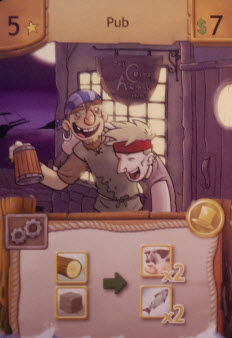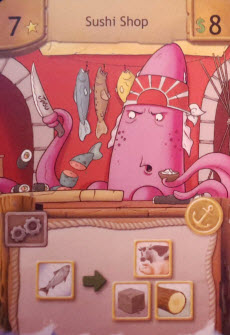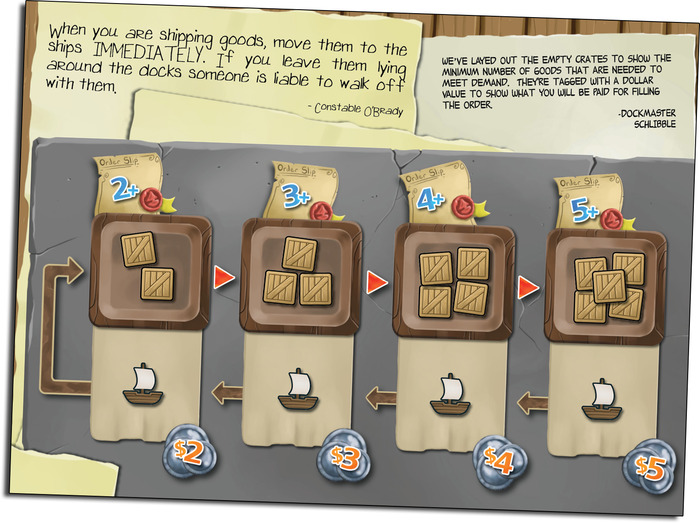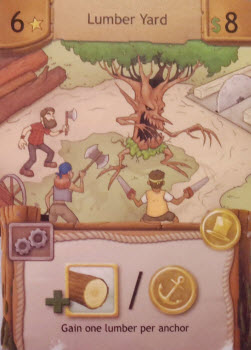So, Harbour is a game about shipping goods….
Wait, wait, wait! Hear me out. It’s only about shipping goods…
Come back!
Did I mention it doesn’t take place in medieval Europe? And that it’s a particularly potent and engaging game that is usually over in a half hour?
No? Well, I’m about to.
Welcome to Harbour: the pint-sized Euro game.
A Bizarre Bazaar

Pubs are a basic necessity.
Prototype Shown
In Harbour, you are a warehouse operator on a thriving fantasy port. All sorts of goods and creatures come through Harbour, and you’ve decided it’s high time you expand your influence in this happening locale. Your goal is to purchase four buildings along the waterfront. It’s up to you and your smooth market management skills to capitalize on your resources and get those buildings as fast as possible.
Unfortunately, because you spent all of your spare capital on frivolous things, like a gold-plated statue of your money, or a pet llama, or the wild promises of a satyr named Ponzi, you’re a bit strapped. All you begin with is a couple unique abilities and just three resources from among the four trade goods Harbour is concerned about: Stone, Fish, Wood, and Livestock.
No exotic resources here; just the basic necessities.
What? Most fantasy folk need to eat and build shelters too. Not everyone survives on Lembas bread and Ogier-built apartments you know.
To gain more resources, players visit various building locations. This is convenient, because your turn consists of simply moving your marker from your current location to a different location and resolving its effect. It’s simple, but you’ll quickly find you have decisions to make.

The Sushi Shop lets you trade one Fish for one of each of the other three resources.
Prototype Shown
Locations provide options on the types and quantities of resources you’d like to get more of. Which locations are available are randomly determined though – at the start of the game, you’ll reveal between five and seven, depending on the number of players. Harbour has a decent amount of buildings (with stretch goals seeking to add even more), and you will see quite a bit of variety each playthrough. For a game designed to be compact, locations afford players a variety of choices each game and replayability over multiple sessions. As a small box game, Harbour packs a lot into its cargo hold.
Instead of a location, players also have an action space they can use on their character sheet that gives them 2-3 options. The most important of these is the ability to buy a building. Since you can’t walk into the Blacksmith and offer to purchase it with Fish (I tried), you’ll need to convert those resources into money. This takes you to the marketplace.
The marketplace dictates the current value of goods (from $2-$5), as well as the needed quantities to sell them. If Stone is currently in the $5 spot, you will need to sell five Stone to get your precious money. You only can have six of any one good, so five is costly. When selling a good, you sell all of it, but you still only get what the market is offering. If you have six Wood and it’s going for $2, now may not be the best time to sell. Resource management in Harbour essential to maximizing those hard-earned good, and it’s how you stay competitive.

The marketplace.
Prototype Shown
After you sell your goods, the value of items in the market changes. Supply and demand and all. Expensive items go down, cheaper items go up, etc.
You may sell as many different kinds of goods as you’re able to, and that money lets you purchase a location. Use it or lose it: there is no vault in Harbour, so money doesn’t carry over between sales. When a location is purchased, you keep it in front of you, and a new location is revealed. Owned buildings can still be used for their actions by players, but anyone other than you who uses your shiny new locale must give you one of their goods. Building locations (and character sheets) also have bonus symbols which do things like reduce future purchase costs, let you keep excess goods after selling them, or ups the reward of certain actions. These give some nice additional incentives for deciding which locations to acquire beyond their VP value.
Compact Efficiency

Never a dull day in Harbour.
Prototype Shown
After someone buys their fourth location, you finish out the round. Then you count up the VP worth of your buildings to determine the winner. Thus, do you focus on getting fewer but more valuable buildings, or do you aim for the cheap-but-affordable ones on the table instead? This could determine if you’re the most savvy investor in Harbor or not. But I like the cut of your jib, so I’m rooting for you.
Harbour is certainly a smaller game of its kind. Designed for 2-4 players, most games of Harbour don’t go beyond a half hour, and even four player players are usually over after 30-45 minutes. This game makes a great choice either if you are time limited or want to teach someone about basic Resource Management and Worker Placement games. In fact, Harbour could easily become a great Gateway Game for learning these mechanics down the line.
Effectively, Harbour takes the best parts of the worker placement genre and distills it into a game that is both concise and energetic but still provides you with a host of valuable decisions to make. Harbour is what you would get if you extracted the best parts of Puerto Rico and made those bits into a 30 minute game. From the fantastic – and often wonderfully ridiculous – artwork to its ease of learning, Harbour succeeds on being a solid game with a time commitment. It’d be one thing to say that Harbour merely scratches that worker placement game itch in a half hour window, but it actually goes one step further and provides you with a complete gaming experience. Given how few resources there are to track and mechanics to worry about, it still manages to make each game a uniquely rewarding experience. Indeed, Harbour passes customs inspections with ease. If you think you’d like to consider adding Harbour to your own warehouse, then go check out their Kickstarter.
We assure you, it’ll be easier than learning about it from Burly Tom on Pier 42…
[sc:Preview-Sealer ]
